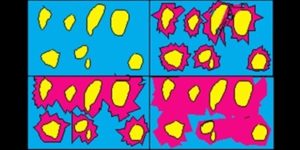Is it me, or is nanotechnology everywhere? It seems to be the new buzzword in the decorative concrete industry. I remember the first time I saw the term. It was in a marketing piece for a high-performance coating a few years back. It caught my eye, since I was not familiar with this cool word that conjured images of “Star Wars” and the jump to light speed. Now, nanotechnology seems to be everywhere, and is has become the magic ingredient in any number of sealers, coatings and stains. My fascination quickly turned to investigation, as I wanted to know what exactly nanotechnology is and what the benefits it brought to the decorative industry.
My first stop, as with most of my research projects, was Google. Amazing what you can find on the Internet. The definition for nanotechnology reads something like this: Nanotechnology is the study of manipulating matter on an atomic and molecular scale. Also referred to as “nanotech,” it generally deals with structures sized between 1 to 100 nanometers in at least one dimension, and involves developing materials or devices within that size. For those of us who do not deal in nanometers on a daily basis, a nanometer is 1 billionth of a meter. For some perspective, a human hair is said to be 80,000 nanometers thick. Bottom line, nanotechnology deals with extremely tiny stuff, far smaller than anything we can see without powerful microscopes.
After gaining a better understanding of what nanotechnology was, my next step was to find someone who deals in the “nano” world on a regular basis. I wanted to know if nanotechnology truly was improving products used in the decorative concrete industry. I contacted Steven Reinstadtler, who is market development manager — construction for the Coatings, Adhesives and Specialties (CAS) division at Bayer MaterialScience AG. He has spent the last 20 years developing polyurethane and polyurea systems for the construction industry.
Reinstadtler says there are three key areas where nanotechnology has led to improvements in the coating and stain industry. The first includes advances in the use of silver at the nano level to improve the biocide properties of coatings. The element silver is a strong biocide. Recent breakthroughs allow it to be incorporated into a coating at a nano level, providing a built-in biocide. Imagine a coating that never needs to be disinfected and that on its own kills any germs that come in contact with it.
The second area involves nanocarbon tubes that allow for greater static discharge. This is important for coatings that are being applied on floors in laboratories and manufacturing facilities where sensitive equipment and research is taking place.
The third area in which nanotechnology developments have impacted the coatings industry is with nanoaluminum oxide, which helps increase abrasion resistance. The ability to manipulate metallic-grit aluminum oxide at such a small scale allows for more of the product to be dispersed into coatings that increase abrasion resistance, resulting in longer service life.
OK, those are all great developments, but what does any of that have to do with the decorative industry? In my opinion, nothing at all! In all my research I could not find one technical paper or any research that relates developments in nanotechnology to any products used in the concrete industry in general. What I did find was that most all coatings and sealers used in our industry are considered nano — not as a result of any recent developments, but rather in that the size of the resin particles in acrylics, polyurethanes, polyureas, polyaspartics, epoxies and so on all fall into the 1-nanometer to 100-nanometer size that defines nanotechnology. One can then surmise that most all coatings, sealers and stains used in the decorative industry use some type of nanotechnology.
This brings me back to where we started. The question still stands. Is the buzz surrounding nanotechnology in the decorative industry real or just a marketing ploy? That is for you to answer. But keep this in mind: Back in the late ’80s the manufacturers of 7UP soda developed a national marketing campaign that touted their product as “caffeine-free.” It was designed to compete against the big cola manufacturers. The campaign was designed to give the impression that 7UP is now caffeine-free. What most people missed was that it had always been caffeine-free. Marketing and advertising is a powerful tool.
What I will finally say is that all of us in the decorative industry have a responsibility to research the products being promoted to make sure they actually perform as promised.















